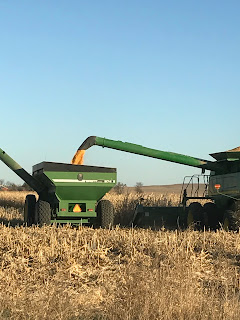Now that beet harvest is FINALLY over, corn harvest is kicking into gear. While all harvest is somewhat stressful, corn harvest seems much more relaxed after the crazy hours of beet harvest. Beets can only be harvested in optimal temperature. If the weather is too hot or too cold, the piler where the beets are collected shuts down. Corn, though, can be picked in most temperatures as long as the crop is dry and the ground isn't too muddy.
 |
| Combine in the field |
On our farm, corn harvest also does not require quite as many workers. For beets, we usually have 6 people working harvest; for corn, we can make it with 3 or 4. The main pieces of equipment used for corn harvest are a combine, grain cart, and semis.
First, the combine goes through the field. The corn is planted in straight rows, so the header fits between each row. The header pulls the corn cobs off of the stalk. The cobs are then sent through a threshing drum where the kernels are beaten from the cob and sent by an auger into the grain tank.
 |
| Going through the last pass on that section |
Once the tank is full, another auger pours the kernels into a grain train. This is one of my favorite parts because it looks like a golden rainbow spilling out. After the grain cart is full, it unloads into a semi.
 |
| Grain train unloading into a semi trailer |
What happens to the rubbage like the stalks and husks though? They are moved along a conveyor and chopped; then they are spit out of the back. Later, the field will be worked to prepare it for the next season's crop.
 |
| A view of the stalks and cobs being sent out |
The full semis go either to a personal grain bin or to the company's elevator bin. Here the process is somewhat similar. The semi trailer, full or corn, opens at the bottom to dump the corn. This corn is then used for feed at feedlots.
 |
| Checking in at the weigh station |
 |
| In line at the elevator |
 |
| Dumping corn at the elevator |








Comments
Post a Comment